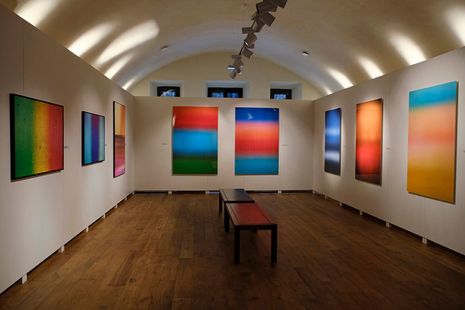‘To breathe and stretch one’s arms again’: repetition and Rothko
Jay Palombella looks at the work of Mark Rothko, the poetry of John Taggart, and their recurrent theme of mindfulness

I recently started following Tracey Emin on Instagram, and in-between watching her online interaction with the continually wonderful account of Richard E. Grant (a strange pairing, I know) I stumbled upon a post of hers about Mark Rothko. In the caption, she recalls the first time she saw a painting by Rothko while walking through the Tate: “I came across this pink and yellow abstract thing, sat down, and cried … it resonated, because I felt it, and I think you should feel from the art, it shouldn’t just be what you are looking at, you have to feel something.”
“Repetition is most interesting in Taggart’s poetry in the way he seems to circle around particular thoughts or sentiments”
This idea of ‘feeling’ is something inherent in Rothko’s own philosophy; he likens his art to a “matter of ending this silence and solitude, of breathing and stretching one’s arms again”. Much like how Emin’s appreciation appears to bypass the silent act of looking, and instead moves towards a physical ‘felt’ response, Rothko’s paintings – in the very construction –depend on an affective breath, or pause, from their onlookers, before an almost physical moment of relief or something more. Rothko’s paintings are abstract, they don’t adhere to traditional ideas of ‘image’ and ‘figure’, so it is perhaps difficult to understand the nature of feeling and affective response to his paintings. It is different to how we might view Van Gogh’s Sunflowers, for example, and be thrown into a feeling of nostalgia, perhaps remembering childhood summers spent in fields with similar-looking sunflowers. His paintings are distinct from this external world and yet inextricably linked to it, creating within themselves a whole world of ‘feeling’. But how is this achieved?
The poet John Taggart spent a while dwelling on this quotation from Rothko in his poem, ‘Slow Song for Mark Rothko’:
“To breathe and stretch one’s arms again
to breathe through the mouth to breathe to
breathe through the mouth to utter in
the most quiet way not to whisper not to whisper
to breathe through the mouth in the most quiet way to
breathe to sing to breathe to sing to breathe
to sing the most quiet way.”
Repetition is most interesting in Taggart’s poetry in the way he seems to circle around particular thoughts or sentiments. In these first lines, the poem seems to hang with an attentive ear to the first half of Rothko’s quote, forcing a ritual of repetition within its very reading as we also come to breathe in, consider, and, in return, quietly sing out this ‘creed’ of Rothko. There is specificity in Taggart’s deconstruction of Rothko’s lines, as if he readily predicts the wrong direction or interpretation we may take before setting us back onto the straight and narrow. Take his later dissection of Rothko’s ambiguous physical response, ‘to stretch one’s arms again’:
“To stretch to stretch to straighten to stretch to
rise to full height not to torture to
give the hand to hold out the hand to
give hope to give hope of perfect rest to
rest not to lay flat not to lay out”
“I don’t think such affective sensations or feelings can ever be properly explained”
Before, in response to Emin, I read this as a sign of relief: that the painting urges us to stretch out our senses and make ourselves at ease again. But as Taggart rightly argues there is also an affective reach into the painting, signalled by this ‘stretch’, of holding out one’s hand – a similar state of ease or ‘feeling’. At first, I think it is still difficult to reconcile such a connection with these seemingly abstract shapes and, to be entirely honest, I don’t think such affective sensations or feelings can ever be properly explained. That being said, I think Gilles Deleuze offers a fair attempt in his work ‘Francis Bacon: The Logic of Sensation’. At its core and simplest, Deleuze’s work argues that abstract paintings use the repetition and variation of certain patterns and colours to replace a traditional idea of a ‘figure’. That is to say that the formal qualities of a painting, what he calls its rhythm, come to form the subject of the work. Much like the repetition of Taggart’s poetic rendering, Rothko’s paintings depend on a similar repeated rhythm, with the continually employed “template of an upright rectangular canvas with a stack of rectangular forms”. Perhaps, then, it is within this rhythmical and spatial familiarity that Rothko’s paintings offer, that they come to motivate such a ‘stretch’ and ‘give hope of perfect rest’.
I’ve dwelt a bit on the idea of feeling art and the ways in which it might be ‘created’, but what is always essential to this notion of ‘feeling’ is the subject experiencing it. A term at Cambridge is, by its nature, stressful, and I think because of this there is a tendency to ignore thoughts or feelings which might seem to distract us from work and revision. Perhaps then, it may be through taking a few moments away from your desk and out to any one of our galleries (though I would recommend Murray Edwards’ new exhibition in particular), that in future terms you can forget about that one supervision essay or past paper for a minute or two, and ‘breathe and stretch one’s arms again’.
 News / Eight Cambridge researchers awarded €17m in ERC research grants27 December 2025
News / Eight Cambridge researchers awarded €17m in ERC research grants27 December 2025 News / Downing investigates ‘mysterious’ underground burial vault 29 December 2025
News / Downing investigates ‘mysterious’ underground burial vault 29 December 2025 Lifestyle / Ask Auntie Alice29 December 2025
Lifestyle / Ask Auntie Alice29 December 2025 Sport / Hard work, heartbreak and hope: international gymnast Maddie Marshall’s journey 29 December 2025
Sport / Hard work, heartbreak and hope: international gymnast Maddie Marshall’s journey 29 December 2025 Interviews / Meet Juan Michel, Cambridge’s multilingual musician29 December 2025
Interviews / Meet Juan Michel, Cambridge’s multilingual musician29 December 2025










